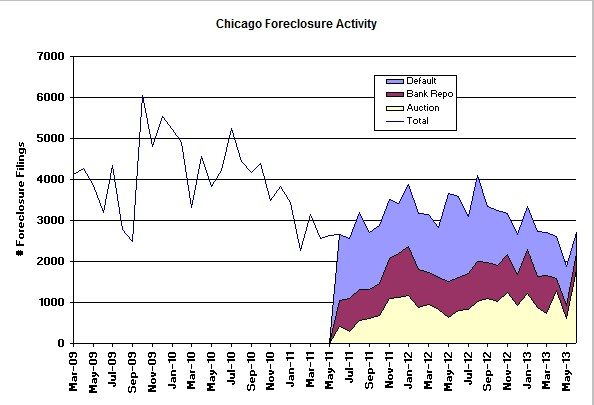When RealtyTrac released their Midyear 2013 U.S. Foreclosure Market Report™ yesterday the headline numbers for Chicago show a spike in “foreclosure activity” as shown in the graph below. However, the spike was primarily driven by an enormous surge in auctions of properties that were already in the foreclosure pipeline. Meanwhile, defaults continued to trend downwards. So the back end of the pipeline is seeing more throughput while the front end is seeing less. In fact, the number of foreclosure auctions hit a record high since I’ve been tracking the data at this level of detail and the defaults hit a record low.
The net effect is that the shadow inventory of foreclosures in Chicago continued to drop. At the end of June it stood at 33,080 homes, which is down a little over 1100 units since May. At the rate of decrease seen in the last few months it will take a little over 2 years to clear this inventory. Of course, things could speed up or slow down before then and as the shadow inventory decreases there is less to clear – i.e. the throughput at the back end will definitely slow down.
Daren Blomquist, vice president at RealtyTrac noted that:
The increases in judicial foreclosure auctions [Illinois falls in this category] demonstrate that these delayed foreclosure cases are now being moved more quickly through to foreclosure completion. Given the rising home prices in most of these markets, it is an opportune time for lenders to dispose of these distressed properties, either at the foreclosure auction to a third-party buyer, or by repossessing the property at the auction and subsequently selling it as a bank-owned home.
If you want to keep up to date on the Chicago real estate market, get an insider’s view of the seamy underbelly of the real estate industry, or you just think I’m the next Kurt Vonnegut you can Subscribe to Getting Real by Email.
